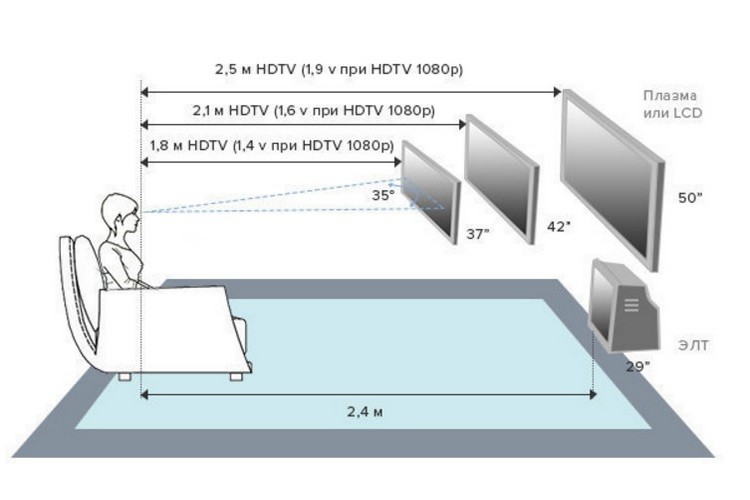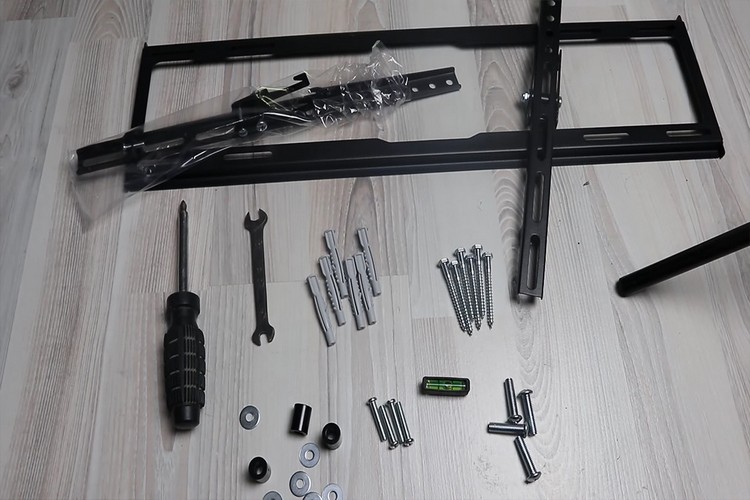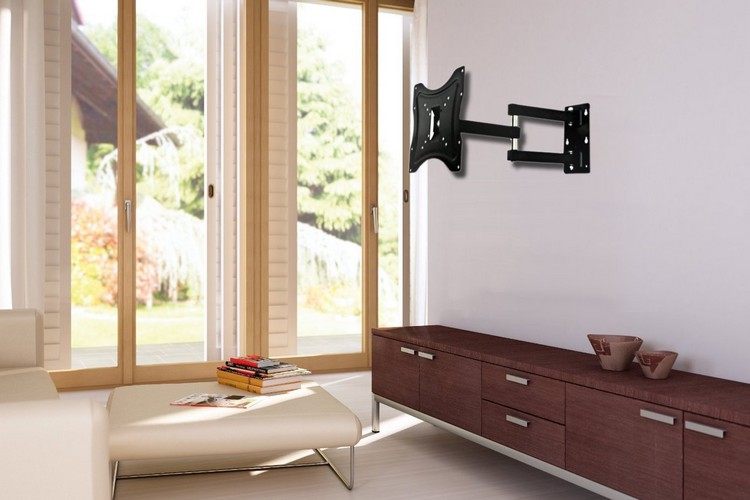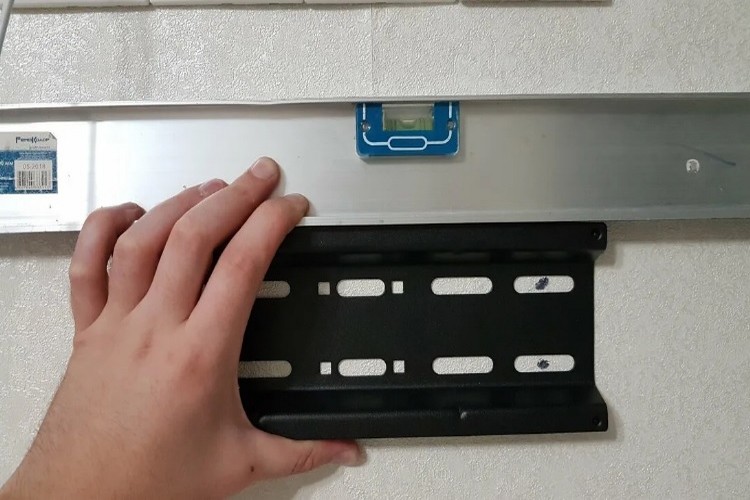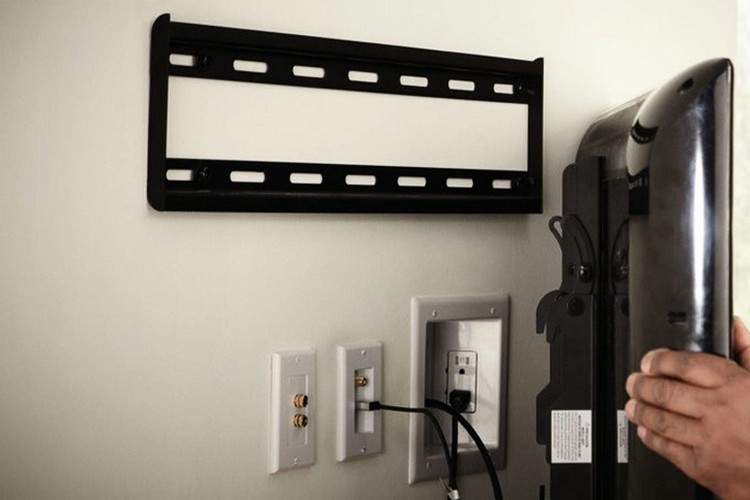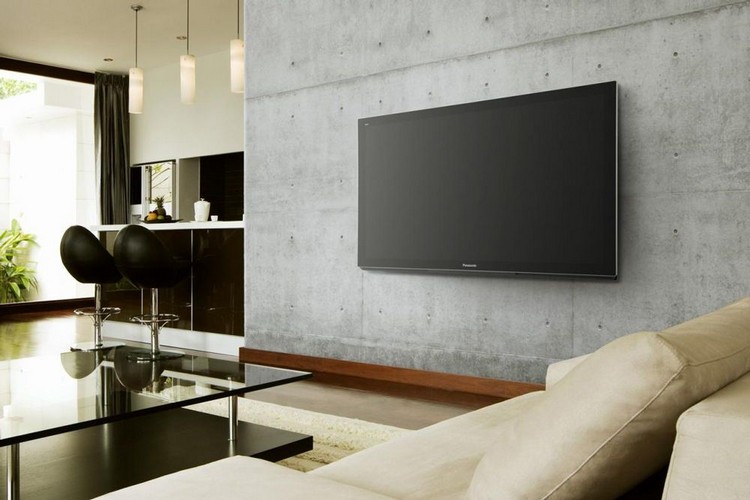How to hang a TV on the wall: mounting TV with and without a bracket
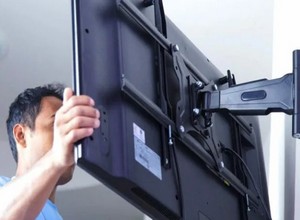 Most modern TVs support their mounting on the wall. For this purpose, there is a special slot on the back for placing a bracket.
Most modern TVs support their mounting on the wall. For this purpose, there is a special slot on the back for placing a bracket.
But you also need to choose the right place for its location, so that watching TV was always comfortable, there was no "glare", as well as the sound was directed exactly to the central part of the room. And the right mounting will also allow you to hide the wires.
So how to attach the TV on the wall and what nuances should be considered in advance?
Contents
How to choose a mounting place
The first thing to start with is to determine the optimal distance to the TV from the viewer's seat (sofa, armchair).
The benchmark is the size of the screen diagonal:
- for 30 inches, 1.1 to 2.3 meters;
- For 34 inches, from 1.3 to 2.6 meters;
- for 42 inches, from 1.6 to 3.2 meters;
- for 50 inches, from 1.9 to 3.8 meters;
- for 55 inches, 2.1 to 3.9 meters;
- for 60 inches, 2.3 to 4.8 meters;
- For 65 inches and larger - from 2.5 meters.
Be sure to check how comfortable it is to watch TV at that distance.
Every person's vision is developed individually. But if possible, you should maintain the maximum possible distance - it minimizes the negative effects on the eyes during prolonged watching TV. That is, for 30 inches - from 2 meters, for 42 inches - from 3 meters, and so on.
Optimal height
Doctors say that the optimal height for the TV is when in a seated position the lower edge of the screen is placed perpendicular to the line of sight. This is the most comfortable position in which the eyes do not get tired even with prolonged viewing.
But at this height on the wall is not always possible to mount the TV. In this case the normal value is 1.2 to 2 meters (from the bottom edge of the screen). Indent from the ceiling is not considered.
Tilt angle
The tilt angle can be adjusted with the bracket.
The optimal value is when the plane of the screen is perpendicular to the line of sight. After all, even a slight deviation in the plane can cause color inversion on the display (on IPS-matrixes it is less noticeable, but black shades still become less saturated).
Accordingly, the higher the TV is mounted, the more you should set its tilt angle. On average it turns out only 10-25 degrees.
What tools are needed to mount the TV on the wall
To mount the TV you will need the following tools:
- An impact drill or screwdriver with a drilling mode ("blow").
- Several screwdrivers (for screwing the dowel).
- Construction level. You can use an ordinary or laser.
- A pencil.
- Vacuum cleaner. Will allow you to drill the wall without unnecessary debris, as well as perform follow-up cleaning.
What brackets for TVs and how they differ
Most manufacturers produce the following bracket options for mounting the screen on the wall:
- Fixed low profile. Represents a horizontal mounting bar. Does not allow you to set the angle of inclination, so it is suitable for those cases when the TV is mounted at a low height (1 - 1.5 meters).
- Fixed ultra-thin. Also made as a horizontal mounting bar. Differs only in thickness. For some TV models, the mount consists of 2 such independent slats (top and bottom). Their advantage is to save space (the distance between the back of the TV and the wall will be literally 3 - 4 millimeters).
- Inclined. Represents a mounting bar on a swiveling "arm" with a lock. Allows you to change the angle of inclination, to slightly move the plane to the left and right.
Tilt, in turn, is also divided into tilt-swivel. They are characterized by a longer "arm" and the ability to "scroll" the plane of the TV. As a rule, these are used only when installing a TV in large halls, in cafes (where you want to change the position of the screen depending on the placement of the audience).
The principle of mounting brackets for TV is the same. Mounted on several dowels, after checking the slats for tear (so they can withstand a load of more than 50 - 60 kilograms of effort).
How to hang a TV on the wall
Conventionally, all work can be divided into the following stages:
- Preparing the wall for installation. Remove wallpaper (if any) - not necessary, but desirable.
- Marking, where the bar will be placed, alignment of the level.
- Mounting the bracket.
- Suspending the TV.
- Final adjustment.
The marking of a wall under installation
Here everything is very simple: you need to choose a place for mounting, then attach the mounting strap or bracket to the wall, align it with the construction level. If the floor and ceiling in the room are not parallel, then the bracket is aligned flat exactly with the ceiling.
Marking is done with a simple pencil. It is necessary to mark the mounting points, that is, where the installation of dowels is provided.
Mounting the bracket
At this stage, and most have various difficulties.
According to the made markings it is necessary to drill the wall for mounting dowels. What to choose? It depends on the material of the wall. It is recommended at least 50 millimeters (7 to 9 mm total diameter).
It is the concrete drill that is used. Of course, if the wall is closed with a layer of drywall, its thickness is added to the size of the dowel (that is, you will get from 75 to 100 millimeters).
What mode to set on the drill? On drywall and wood - without impact, concrete, cinder block, brick, aerated concrete, foam blocks - with impact.
From below it is recommended to hold the pipe of the included vacuum cleaner - this will prevent the flight of construction dust (very harmful to electrical equipment, including TV).
What type of dowels to use? It is also recommended to choose according to the material of the wall. Naturally, taking into account the potential load on the entire bracket.
By the way, some TV mounts (which are sold separately) already come with all the necessary materials for installation. But the complete dowels are not always of high quality and sufficient length: this nuance should be taken into account in advance.
Basic recommendations:
- For drywall. Metal "butterfly dowels" should be used. That is, which when screwing are divided into "petals". In this case, the load is distributed over a larger area, which will eliminate the likelihood of rupture of the plane of the plasterboard wall.
- For loose or hollow materials. It is recommended to use chemical dowels, which fill the voids of the building material. It should be noted that such dowels do not cure completely immediately, but within 12 - 24 hours (it is necessary to specify in the instructions).
- For very thin walls. Instead of dowels, it is recommended to use bolts, studs. That is, drill a hole through, then - fix the bar on both sides (tighten the washer and nut). This is the most reliable option, the load will also be distributed over a relatively large area.
Suspending the TV
If there is a plug in the back of the TV at the place of mounting the bracket - it must be removed beforehand (it is recommended to study the instruction manual for the TV).
As a rule, all TVs (LG, Samsung, etc.) are mounted in a similar way - you need to "put" the TV panel on the mounting plate from the side. And after that you can adjust the position, the tilt angle.
Some TVs have a plug on top of the bracket. In this case all connection cables are routed at once. There are holes in the bracket for this purpose.
Final adjustment
The final adjustment should be understood as connecting all cables, turning on the power, adjusting the angle of tilt and the final position of the TV panel.
What you can use instead of a bracket
Bracket for the TV has a fairly simple design. But at the same time their average cost - from 1.5 to 6 thousand rubles. But it really can be made yourself from improvised materials.
From an aluminum angle
The optimal thickness - from 3 millimeters and more.
You can also use steel corners, but they are much harder to work with (drill, cut, grind).
You will need only 4 corners. Two of them will be fixed to the back of the TV (in the place where the bracket is supposed to be installed), two more will be fixed to the wall itself.
Fixing the slats is done with steel brackets. The most difficult thing in all this is to make correct measurements. You should be guided by the mounting on the TV itself.
Furniture brackets
Can be used for small TVs (32-40 inches). There are also such corners are already perforated (they are mainly made of steel).
Similar in design corners, by the way, are used in the installation of wooden supporting structures. That is, you can buy them in the nearest store building supplies (average price - 15 rubles apiece, you will need 4 - 8 of these).
Swivel bracket from pipes
One of the most reliable options, but will also need a grinder, drill (with a drill on metal), welding machine.
The basic scheme is as follows:
- To the mounting bar of steel or sheet metal (from 3 millimeters and thicker) is welded a pin.
- To the TV mount (you can also make a mounting bar) attached a "node" that can be inserted into the pins of the first mounting bar.
The main advantage of such a mount - you will be able to adjust the position, tilt angle. You can use a regular "hexahedron" as a fixer for the guide node (like in the mounts for the street antenna).
Mounting the cables
If it is necessary to hide all the cables and wires, it is recommended to form a false plinth directly on the wall (match the color of paint or wallpaper, to visually hide the mounting components). All necessary wires are threaded through it - and then threaded through the hole in the bracket.
If there is no compartment for fixing wires in the mount (this is most common in older brackets that were produced for TVs in 2010 - 2015), then the wires are led underneath and there - fixed with double-sided adhesive tape.
The most important thing is to make sure that none of the wires is bent when turning, adjusting the angle.
If the main ports for connection are not placed at the bottom side, but exactly at the back (i.e. the cables will be tucked into the wall), it is recommended to use angular adapters. They are available for HDMI, VGA, DVI and RCA. As a last resort, you can use a remote set-top box with all the necessary ports (most of them have wall mounts for ordinary self-tapping screws).
All in all, fixing the TV on the wall is quite easy. The main advantage of this method of placing the TV - there is no need to allocate space for the installation of a cabinet (which, on average, takes 1.5 - 2 square meters of free space).
The most difficult thing is to choose the right dowels for the wall material.
Useful video
All about how to hang a TV on the wall, you'll learn in this video:



